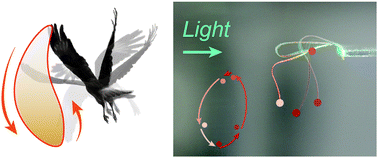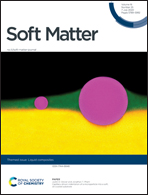Design principles for non-reciprocal photomechanical actuation†
Abstract
Non-reciprocal motions are a sequence of movements exhibiting time-reversal asymmetry. Such movements are common among various natural species, being adopted as a typical strategy for achieving efficient locomotion. Generally, the realization of non-reciprocal motions in man-made robotic devices requires synchronous control of at least two individual actuators, hence posing challenges to soft micro-robotics where the miniaturization limits integration of different mechanical components and the possibility of using onboard batteries. Here, we introduce general concepts for achieving non-reciprocal movements in wirelessly controlled soft actuators made of photomechanically responsive liquid crystal networks. The monolithic actuators are composed of two segments that can be actuated photochemically and photothermally, and the non-reciprocal motion is obtained by a control sequence that temporally modulates light sources of different wavelengths. Through proper selection of photoactive compounds, the number of modulated light sources can be decreased, from three to two, and eventually to one. Finally, we demonstrate non-reciprocal self-oscillation by self-shadowing effect in a flexible strip under a constant light field with no temporal modulation. This study provides general guidelines to light-controlled non-reciprocal actuation, offering new strategies for the control of wireless soft micro-robotics.



 Please wait while we load your content...
Please wait while we load your content...